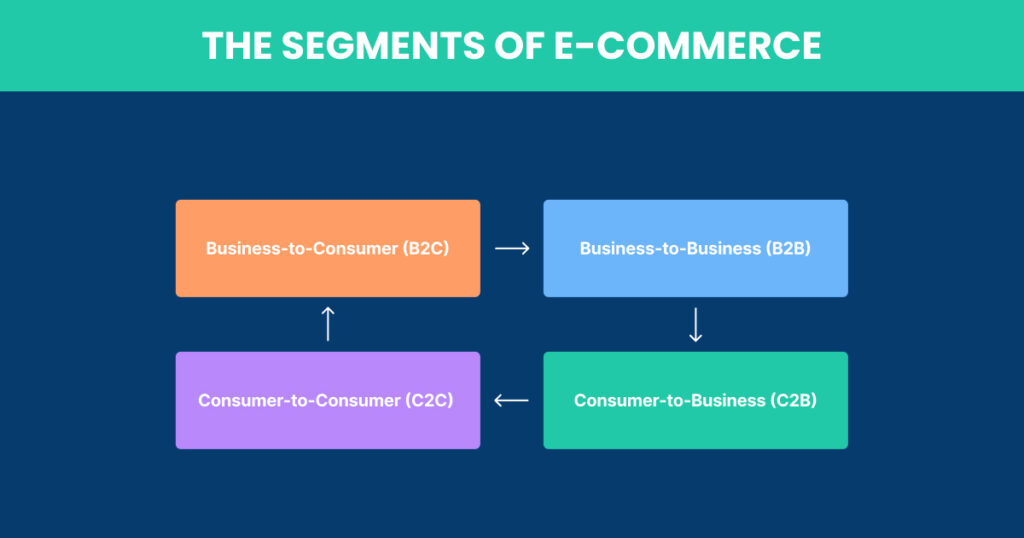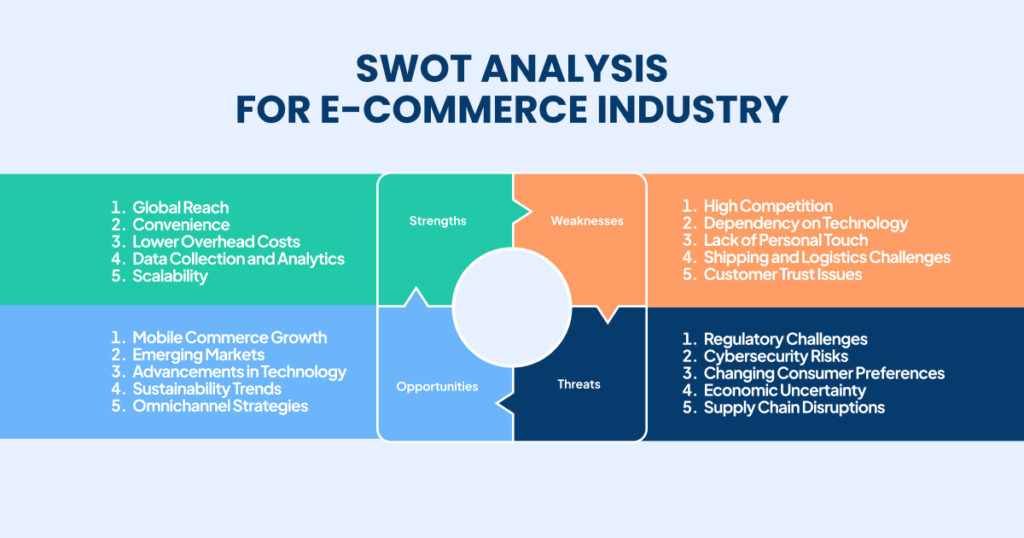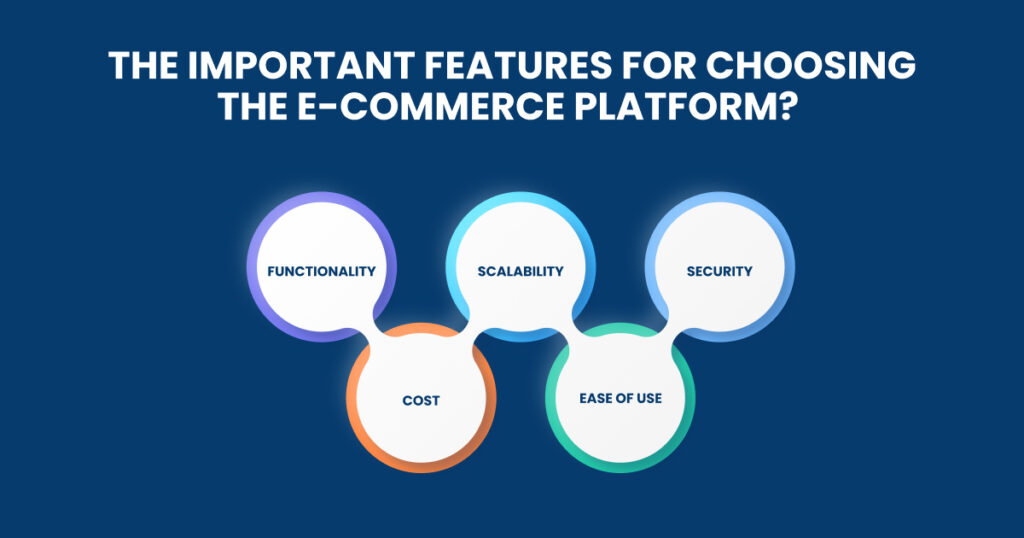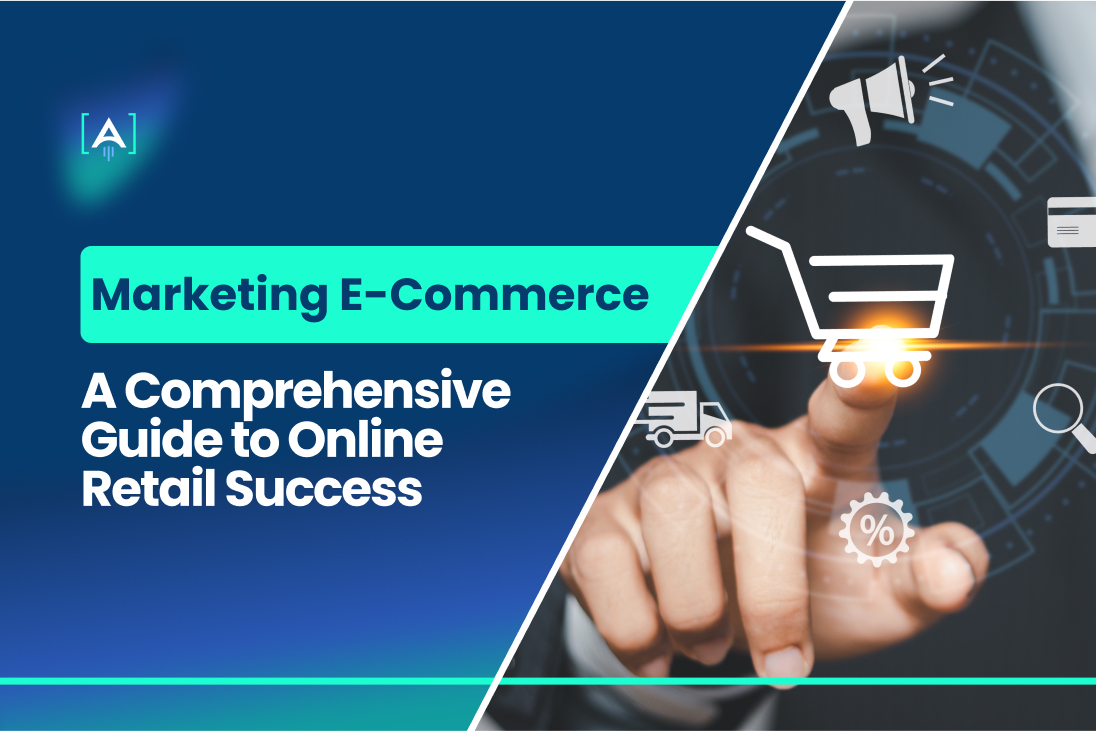We won’t invent a bicycle while saying that growth marketing is everywhere.
E-commerce is not the exception. In other words, we can call it Marketing E-commerce.
The phenomenon of an online store and constant online sales shift how people shop.
As a result, the E-commerce marketing agency is the helping hand.
In 2024, global retail e-commerce sales will surpass 6.3 trillion U.S. dollars.
This blog post will detail the foundations of E-commerce, its importance for entrepreneurs, and the strategies for Online Retail Success.
The Foundations of E-commerce
Electronic commerce, commonly known as e-commerce, refers to the buying and selling of products and services online.
This digital marketplace has transformed how businesses operate, and consumers shop, providing unprecedented convenience and accessibility.
The foundation of e-commerce rests on several key components:
- user-friendly website or app
- secure payment gateways
- robust inventory management
- efficient logistics
These elements work together to create a seamless shopping experience for customers and productive operations for online stores.
Source: Statista
According to Statista, among the leading figures in the global market, the Chinese retail giant Alibaba is recognized as the largest e-commerce retailer worldwide, commanding a 23 percent market share.
What are the E-Commerce Segments?
E-commerce is divided into several segments.

Business-to-Consumer (B2C)
Definition: B2C e-commerce involves transactions between businesses and individual consumers. It’s the most recognizable segment of e-commerce, where online businesses sell products and services directly to end-users.
Responsibilities:
- Online Retail Sales: B2C companies are responsible for delivering a wide array of products through online retail sales platforms.
- Customer Experience: Providing an intuitive and seamless shopping experience is critical, from browsing to payment.
- Customer Loyalty: Building and maintaining customer loyalty through personalized marketing, loyalty programs, and extraordinary customer service.
Customer Interaction:
- Direct Engagement: Businesses interact directly with consumers through their websites and apps, ensuring a smooth online purchase process.
- Support Services: Comprehensive customer support, including live chat, FAQs, and return policies.
- Digital Marketing Strategies: Utilizing SEO, PPC advertising, email marketing, and social media to increase traffic and revenues.
Examples: Amazon, Walmart, and Alibaba are leading B2C e-commerce companies known for their extensive product ranges and superior customer experiences.
Business-to-Business (B2B)
Definition: B2B e-commerce involves business transactions, companies marketing items or services to other businesses rather than individual consumers.
Responsibilities:
- Supply Chains: Providing products businesses need to operate, such as raw materials, office supplies, or technology solutions.
- Customized Solutions: Often involves tailored solutions and bulk sales to meet specific business needs.
- Customer Loyalty: Developing strong, long-term relationships through consistent and reliable service.
Customer Interaction:
- Consultative Sales: Typically involves a more consultative sales approach, with account managers and personalized service.
- Advanced Platforms: Using sophisticated online platforms that facilitate large transactions, custom orders, and integrated systems.
- Digital Marketing Strategies: Focusing on content marketing, webinars, and SEO to attract business clients.
Examples: Alibaba’s wholesale platform and ThomasNet are prime examples of B2B e-commerce companies.
Consumer-to-Consumer (C2C)
Definition: C2C e-commerce involves transactions between consumers, usually facilitated by a third-party platform that provides a marketplace for individuals to purchase and sell items.
Responsibilities:
- Marketplace Services: Providing the infrastructure for individuals to list, sell, and purchase items.
- Trust and Safety: Ensuring safe and secure transactions, often through ratings, reviews, and dispute resolution services.
- Customer Loyalty: Encouraging repeat use through a reliable platform and positive user experiences.
Customer Interaction:
- Peer-to-peer: Direct transactions between consumers with minimal business interference.
- Support Mechanisms: Platforms offer payment processing, shipping, and dispute resolution support.
- Digital Marketing Strategies: Leveraging SEO, social media, and email marketing to attract users and drive platform engagement.
Examples: eBay, Craigslist, and Poshmark are notable C2C platforms.
Consumer-to-Business (C2B)
Definition: C2B e-commerce is a model where individuals sell products or services to businesses, reversing the traditional business-to-consumer model.
Responsibilities:
- Service Marketplace: Platforms that connect individuals offering services or products to businesses looking for those specific offerings.
- Quality Assurance: Assuring the quality and reliability of services provided by individuals.
- Customer Loyalty: Building trust through transparent transactions and reviews, encouraging repeat business.
Customer Interaction:
- Freelancer Platforms: These often involve freelance services where individuals offer their skills to businesses.
- Direct Transactions: Individuals directly sell their services or products to businesses.
- Digital Marketing Strategies: Using SEO, targeted advertising, and content marketing to attract individual service providers and businesses.
Examples: Upwork, Freelancer, and Shutterstock facilitate C2B transactions.
Each e-commerce segment has unique customer interaction characteristics and approaches, leveraging digital marketing strategies to drive success and foster customer loyalty. These segments collectively contribute to the dynamic and ever-evolving landscape of online business.
Why E-commerce Marketing is Essential for Entrepreneurs?
E-commerce marketing is crucial for entrepreneurs aiming to thrive in today’s competitive digital landscape.
Effective and innovative marketing strategies are the nature of any successful e-commerce company, driving traffic, conversions, and customer loyalty.
Without robust marketing, even the most innovative products can remain unnoticed.
Driving Traffic to Your Online Store
For an e-commerce business, attracting visitors to your online store is the initial step toward success.
Employing digital marketing methods such as search engine optimization (SEO), pay-per-click (PPC) advertising, and social media marketing can significantly boost visibility.
- SEO assists your site in ranking higher in search engine results, facilitating potential customers in discovering you.
- PPC ads target specific demographics, ensuring that your online purchase ads reach the right audience.
- Social media sites like Facebook, Instagram, and LinkedIn are invaluable for promoting products and engaging with customers, driving more traffic to your site.
Enhancing Customer Experience
Marketing E-commerce is not just about attracting visitors; it’s also about enhancing the customer experience to turn visitors into buyers.
Personalization is key in today’s online shopping environment. Using data analytics, e-commerce businesses can tailor their marketing efforts to individual customer preferences, offering personalized recommendations and targeted promotions.
Email marketing campaigns, for example, can be customized to deliver relevant content and special offers, improving engagement and conversion rates. A seamless, personalized shopping experience encourages repeat business and fosters customer loyalty.
Building Brand Awareness
Building brand awareness is essential for distinguishing your e-commerce company from competitors in a crowded market.
- Content marketing, including blogs, videos, and infographics, helps establish your brand as an authority in your industry. High-quality content that provides value to customers can enhance your brand’s reputation and encourage sharing across social media platforms.
- Influencer marketing is another effective strategy; collaborating with influencers who have a large and engaged following can amplify your reach and credibility.
Maximizing Sales and Revenue
Effective e-commerce marketing strategies are directly linked to maximizing sales and revenue. Techniques such as upselling and cross-selling can boost the average order value. Retargeting campaigns remind visitors of products they viewed but didn’t purchase, nudging them toward completing their transactions.
Seasonal promotions and flash sales create a sense of urgency, prompting immediate online purchases. Additionally, utilizing customer reviews and testimonials can build trust and persuade new customers to buy from your e-commerce business.
Utilizing Data-Driven Insights
Data-driven insights are a cornerstone of successful e-commerce marketing. Analytics tools allow entrepreneurs to track customer behavior, measure the strength of marketing campaigns, and make informed decisions.
Understanding which strategies work best enables continuous improvement and optimization. For instance, A/B testing different elements of your website or marketing emails can reveal what reproduces the most with your audience, helping you refine your approach for better results.
How to Define Your E-commerce Marketing Goals and Objectives
Defining clear and achievable marketing goals is compelling for any e-commerce business looking to thrive in the competitive online commerce landscape.
Setting well-defined objectives helps create focused strategies that boost online sales, attract customers, and enhance overall business performance. Here’s how to define your e-commerce marketing goals and objectives:
Conduct a SWOT Analysis
A clear SWOT analysis (Strengths, Weaknesses, Opportunities, and Threats) is the first step in setting your e-commerce marketing goals. The analysis helps identify internal strengths and weaknesses within your e-commerce business, such as a robust e-commerce website or limited mobile commerce capabilities.

It also examines external opportunities and threats, such as emerging market trends or increased competition. By understanding the factors, you can set realistic goals that boost to your strengths and address your weaknesses while also capitalizing on opportunities and mitigating threats.
Define Specific, Measurable Goals
When setting marketing goals, ensure they are Specific, Measurable, Achievable, Relevant, and Time-bound (SMART).
For example, instead of a vague goal like “boost sales,” specify a target such as “increase online sales by 20% over the next six months.”
This clarity enables better planning and performance tracking. Measurable goals allow you to monitor progress and make necessary adjustments.
Analytics tools can assist you in tracking metrics like conversion rates, average order values, and customer acquisition costs.
Focus on Customer Acquisition and Retention
Your e-commerce marketing goals should include acquisition and retention strategies to attract customers. Customer acquisition goals might involve increasing traffic to your e-commerce website through SEO, PPC advertising, and social media campaigns.
According to a recent study, businesses implementing comprehensive SEO strategies see a 14.6% conversion rate from organic search, significantly higher than traditional outbound methods.
On the other hand, customer retention goals might focus on enhancing the shopping experience, personalizing marketing efforts, and implementing loyalty programs to encourage repeat purchases.
Leverage Mobile Commerce
Given the rise of mobile commerce, including mobile-specific objectives in your marketing goals is essential.
In 2027, Statista expects $3.4 trillion of mobile e-commerce sales, a stark contrast to the $982 billion generated in the segment as recently as 2018.
Source: Statista
Goals might include optimizing your e-commerce website for mobile users, developing a mobile app, or implementing mobile-specific promotions to boost sales. Ensuring a seamless mobile experience can significantly enhance customer satisfaction and increase engagement.
Set Benchmarks and Monitor Performance
Setting benchmarks based on industry standards or past performance is crucial for measuring success.
For example, if the average conversion rate in your industry is 2.5%, setting a goal to achieve or exceed this rate can provide a clear target.
Monitor key performance indicators (KPIs) such as traffic, conversion rates, and customer lifetime value regularly to gauge the effectiveness of your strategies. Use these insights to continually refine your goals and tactics.
How to Choose the Right E-commerce Platform and Tools
Choosing the right e-commerce platform and tools is critical for establishing a successful business online. The right platform not only supports your e-commerce website but also drives e-commerce sales by providing essential features and functionalities.

When selecting an e-commerce platform, consider its user-friendliness and ease of setup. These factors can save time and reduce complexity.
Robust scalability is vital for supporting business growth, ensuring the platform can keep increased traffic and transactions as your business expands.
Look for comprehensive features such as inventory management, customer relationship management (CRM), and integrated payment gateway tools to simplify operations and improve the shopping experience.
Security is paramount; choose a platform with advanced security measures to keep sensitive customer data and prevent breaches.
How to Implement E-commerce Marketing Tactics and Techniques?
Implementing e-commerce marketing tactics and techniques is a dynamic and ongoing process that requires a strategic approach and constant adaptation to changing market conditions.
By leveraging various strategies, e-commerce businesses can attract more visitors, convert those visitors into customers, and foster long-term loyalty. Below are the key tactics and techniques, their importance, and the most commonly used methods in the industry.
Key Tactics and Techniques
- Search Engine Optimization (SEO)
Importance: Enhances website visibility on search engines, driving organic traffic.
- Techniques:
- Keyword Research: Identifying relevant keywords for product descriptions and blog posts.
- On-Page SEO: Optimizing meta titles, descriptions, and URLs.
- Content Creation: Producing high-quality, engaging content.
- Link-Building: Acquiring backlinks from reputable sites.
- Pay-Per-Click (PPC) Advertising
Importance: Provides immediate visibility and drives targeted traffic.
- Techniques:
- Google Ads: Running search and display ads.
- Social Media Ads: Utilizing platforms like Facebook, Instagram, and LinkedIn.
- Retargeting Ads: Re-engaging users who have previously visited your site.
Importance: Facilitates direct communication with customers, leading to higher conversion rates.
- Techniques:
- Segmentation: Dividing email lists into targeted groups.
- Personalization: Tailoring emails to individual preferences and behaviors.
- Automation: Setting up automated campaigns for abandoned carts, welcome series, and follow-ups.
Importance: Engages with a broad audience, building brand awareness and loyalty.
- Techniques:
- Content Marketing: Sharing valuable content to educate and entertain.
- Influencer Partnerships: Collaborating with influencers to reach new audiences.
- Social Commerce: Enabling purchases directly through social media platforms.
- Content Marketing
Importance: Attracts and retains a clearly defined audience, driving profitable customer action.
- Techniques:
- Blogging: Writing informative and engaging articles.
- Video Content: Creating product demos, tutorials, and customer testimonials.
- Infographics: Using visual data to explain complex concepts.
Importance: Provides insights into customer behavior, enabling data-driven decisions.
- Techniques:
- Web Analytics: Monitoring traffic sources, user behavior, and conversion rates.
- Sales Analytics: Tracking sales performance and identifying trends.
- A/B Testing: Testing different versions of web pages or emails to optimize performance.
Why These Tactics and Techniques Are Important
- Driving Traffic: SEO and PPC are crucial for attracting potential customers to your website. SEO builds long-term organic traffic, while PPC provides immediate results.
- Increasing Conversion Rates: Email and content marketing engage customers and guide them through the buying journey, increasing the likelihood of conversion.
- Building Brand Awareness: Social media marketing helps build a strong brand presence, making your business more recognizable and trustworthy.
- Customer Retention: Personalized email campaigns and content keep customers engaged and loyal, increasing their lifetime value.
- Data-Driven Decisions: Analytics and reporting provide valuable insights that help refine marketing strategies and improve overall performance.
Implementing these e-commerce marketing tactics will significantly enhance the likelihood of success.
Moreover, these strategies create a holistic approach that drives immediate results and fosters long-term growth, making them essential for achieving sustained success in the competitive e-commerce landscape.
Partner with [A] Growth Agency for Your E-Commerce Business
Achieving online retail success requires more than a great product. We should accept that it demands a strategic approach to e-commerce marketing.
[A] Growth Agency is always there for you! Your ideal partner in this journey will offer you the specific services designed to benefit your e-commerce business.
We treat every business as a unique entity. Our strategies are tailor-made, and we’re not afraid to experiment to find the best path forward.
If this approach is relevant to your motivation, then go ahead!

